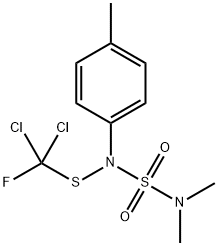Uses
Tolylfluanid is used to control a wide range of fungal diseases on
apples, grapes, strawberries and other fruit and storage diseases on many
crops.
Uses
Tolylfluanid may be used as a reference standard for the determination of the analyte in nutraceutical formulations using dispersive liquid-liquid microextraction(DLLME) coupled with gas chromatography-mass spectrometry method.
Definition
ChEBI: A member of the class of sulfamides that is dichlofluanid in which the hydrogen at the para position of the phenyl group is replaced by a methyl group. A fungicide first marketed in 1971 and used in the cultivation of fruit and vegetables, as
ell as in wood preservatives, it is no longer approved for use in the European Union.
Metabolic pathway
Tolylfluanid contains an unstable dichlorofluoromethylthio (sulfenyl)
moiety that has been shown to undergo rapid hydrolytic and metabolic
degradation to dimethylaminosulfotoluidide (2). By analogy with captan,
presumably the dichlorofluoromethylthio moiety can be transferred to the
sulfur atoms of cellular thiols such as cysteine and glutathione. Thus, in
the presence of thiols tolylfluanid is probably cleaved at the N-S bond to
form thiophosgene or its monofluoro analogue (3) and other gaseous
products such as hydrogen sulfide, hydrogen chloride and carbonyl sulfide.
Thiophosgene or its monofluoro analogue is rapidly hydrolysed by
water. The dichlorofluoromethylthio group and thiophosgene may be
intermediates in the formation of addition products, for example addition
to cysteine affords thiazolidine-2-thione-4-carboxylica cid (4). A thiazolidine
derivative of glutathione may also be formed. The main metabolic
reactions in all media were cleavage of the N-S bond to give dimethylaminosulfotoluidide
(2) followed by hydroxylation of the phenyl ring and
oxidation of the methyl substituent on the phenyl ring. Glucoside conjugates
were detected in plants and the cysteine adduct, thiazolidine-2-
thione-4-carboxylic acid (4), was formed in rats.
Degradation
Tolylfluanid is hydrolysed rapidly in alkaline conditions. The hydrolytic
DT
50 is about 12 days, 29 hours and <10 minutes at pH 4,7 and 9, respectively,
at 22 °C. In the environment, hydrolysis is faster than photolysis
(PM; PSD, 1995). Tolylfluanid does not absorb light of wavelength >295
nm and so photodegradation is unlikely to occur in the absence of
photosensitisers.



